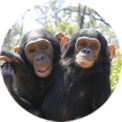Compositionality in Chimpanzee Communication?
Linda Oñai, Katja Liebalii, and Wendy Sandleriii
iMax Planck Institute for Human Development, Berlin, Germany, iiFree University of Berlin, iiiUniversity of Haifa
Language evolution research seeks commonalities and differences between non-human primate communication and human language. One important feature of human language, compositionality, lends language a high degree of flexibility and is thought to be a uniquely human characteristic. We studied multimodal expressions in our closest living relative, the chimpanzee, and investigated whether hand gestures and facial expressions recombined to create different complex meanings. In our analysis, ‘meaning’ was attributed to signals on the basis of both context of use and response of recipients. We focused on two variations of the extended arm gesture -- Arm Stretched (AS) and Arm Offer (AO) -- in isolation, and in combination with two facial expressions, Bared Teeth (BT) and Funneled Lips (FL). In positive contexts, both hand gestures elicited an affiliative response when used in isolation, while their combination with the BT facial expression modulated the recipient’s response in different ways. BT+AS elicited a significantly higher frequency of affiliative responses than AS alone, while BT+AO resulted in lower frequency of affiliative responses than AO alone. Our study identifies distinct components that recombine to trigger different response tendencies – and thus represents a first step in exploring compositionality in chimpanzee multimodal expressions.







